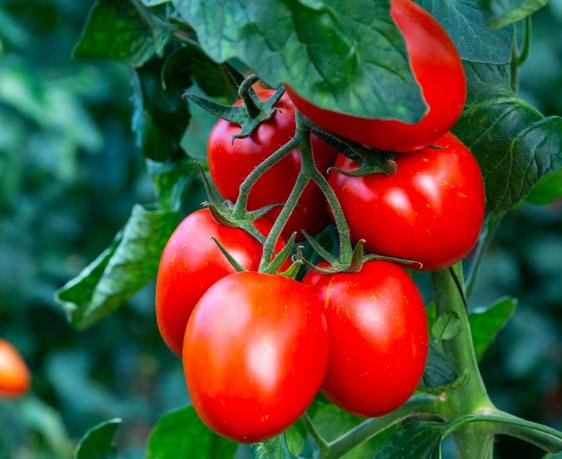
6 minute read
Success Is in the Soil

DE LA TE r rr o E À LA TABLE F ro M THE EA TH T THE TABLE LE SUCCÈS EST DANS la terre


Voici quelques questions courantes et leurs réponses pour aider les jardiniers et les jardinières voulant offrir le meilleur à leurs plants de tomates et compagnie.
THE SUCCESS IS IN the Soil
Here are some common questions and answers for gardeners wanting to give to their tomato plants and other vegetables the best possible conditions.
Mettez toutes les chances de votre côté
Nos engrais naturels sont approuvés pour la culture biologique. Afin d’obtenir une récolte abondante et de maximiser les résultats, appliquez l’engrais autour des plantes potagères toutes les 4 semaines.
Stack the Odds in Your Favour
Our natural fertilizers are approved for organic gardening. In order to obtain a bountiful harvest and to maximize results, apply fertilizer around vegetable plants every 4 weeks.
Texte/Text : Véronique Lajoie Directrice générale / General Manager Ferme horticole Lajoie (Passion Jardins)
www.famillelajoie.com
QUELLE ÉPAISSEUR DE BONNE TERRE DOIS-JE UTILISER POUR OBTENIR DES RÉSULTATS AU POTAGER?
La réponse est simple : il suffit d’imaginer la croissance de belles grosses et longues carottes sucrées! Moins de terre meuble et plus de terre compactée produira des carottes de piètre qualité. Plus nous offrons un milieu sain aux racines de nos plantes, moins elles exigent d’entretien, soit d’arrosage et d’apport en nutriments. Donc, tout jardin qui se respecte doit contenir un minimum de 30 cm (12 pouces) de bonne terre.
«ROTOCULTER» OU NE PAS «ROTOCULTER», TELLE EST LA QUESTION!
Nous avons toujours vu nos grands-parents labourer la terre à l’aide d’un rotoculteur, mais cette pratique, bien qu’elle offre de belles récoltes, est révolue. Retourner la terre chaque printemps détruit la structure du sol et met en péril tous les microorganismes qui sont nos alliés pour une production généreuse. Il est préférable de décompacter la terre, par exemple en utilisant une grelinette. On évitera également de piétiner la terre, car on la priverait ainsi de son air, et les racines manqueraient d’espace pour croître. On ajoutera aussi du compost chaque saison. La vie microbienne du sol s’activera et nous aidera à garder notre sol meuble. Évidemment, si nous ouvrons une nouvelle parcelle de jardin, il serait intéressant de «rotoculter» une première (et dernière) fois.
HOW DEEP SHOULD GOOD SOIL BE FOR BEST RESULTS IN THE VEGETABLE GARDEN?
The answer is simple: just imagine growing big, long, sweet carrots! Soil that is less friable and more compacted will produce poor quality carrots. The more we provide a healthy environment for the roots of our plants, the less maintenance they require, such as watering and supplying nutriments. So you’ll need a minimum of 12'' of good rich soil for any self-respecting garden!
“TO TILL OR NOT TO TILL,” THAT IS THE QUESTION!
We grew up watching our grandparents plowing the land with a rotary tiller, but this practice, although it yields good crops, is a thing of the past. Turning the earth each spring destroys the soil’s structure and endangers all the micro-organisms that contribute to a generous harvest. It’s best to de-compact the soil using a broad fork, for example. You should also avoid trampling the soil, as it will deprive it of its air, and the roots will lack space to grow. You should also add some compost each season. That way microbial life in the soil will activate and help keep the soil friable. Obviously, if you begin to use a new plot in the garden, tilling it for a first (and last) time isn’t a bad idea.


QUE DOIS-JE APPLIQUER : UN ENGRAIS OU UN COMPOST?
Nous vous répondrons très simplement : les deux sont importants pour une belle croissance et une production abondante. Les engrais comme le 4-5-7 apportent des nutriments aux végétaux. L’équivalent humain serait un ajout de vitamines dans notre alimentation. Le compost marin Passion Jardins®, pour sa part, donne de la matière organique et de la structure au sol, ce qui l’allège, retient l’humidité et permet aux micro-organismes d’être bien actifs afin de pouvoir digérer l’engrais et de le rendre ainsi disponible pour nos végétaux. La combinaison de compost en début de saison et d’engrais naturel aux 4 semaines est le cocktail parfait pour le succès!
LE PAILLIS DE CÈDRE EST-IL LE BIENVENU AU POTAGER?
Non, pas vraiment. Le paillis de cèdre, sans qu’on le veuille réellement, aura tendance à être enfoui lors de nos travaux de désherbage ou de plantation. Comme il se décompose très lentement, nos précieuses nouvelles pousses auront de la difficulté à s’enraciner à cause de la présence de copeaux. On privilégie donc le paillis de bois raméal fragmenté, le paillis forestier, la paille ou même les feuilles mortes, qui se décomposeront plus rapidement et enrichiront le sol en conséquence.
SI JE CULTIVE EN CONTENANTS, DOIS-JE CHANGER LA TERRE CHAQUE ANNÉE?
Oui, il serait préférable de changer la terre. Celle-ci peut être mise au compost ou étendue dans les platebandes. La production de certains légumes et fruits (tomates, poivrons, courges) est très exigeante. Si la récolte a été bonne, les nutriments auront été consommés par la plante, et le terreau sera dorénavant compact. Un terreau pour contenant Passion Jardins® avec une belle poignée de compost marin suivie de quelques cuillerées d’engrais 4-2-7 feront le bonheur de votre plant de tomates et de votre assiette! Évidemment, si vous détenez d’immenses bacs, ceux-ci pourront être traités au même titre que des planches de culture permanente en recevant une bonne dose de compost chaque printemps.
Évitez d’économiser sur la base du potager. La terre, le compost, l’engrais et le paillis font partie intégrante de sa réussite! Offrez donc la crème de la crème à vos végétaux.
The answer is simple. Both are important for good growth and abundant production. Fertilizers like 4-5-7 provide nutrients to plants. For us, it would be like adding vitamins to our diet. Passion Jardins Sea Compost, though, provides organic matter and structure to the soil, which lightens it, retains moisture and causes the microorganisms to be very active in order to be able to digest the fertilizer and thus make it available for our plants. The combination of compost at the start of the season and natural fertilizer every 4 to 6 weeks is the perfect cocktail for success!
IS CEDAR MULCH SUITABLE FOR A VEGETABLE GARDEN?
Not really. Cedar mulch tends to get buried during weeding or planting work. As it decomposes very slowly, our precious new growth will have a hard time taking root due to the presence of chips. Better options are ramial chipped wood mulch, forest mulch, straw or even dead leaves, which will decompose more quickly and enrich the soil accordingly.

IF I GROW IN CONTAINERS, DO I HAVE TO CHANGE THE SOIL EVERY YEAR?
It’s better to change the soil. This can be put into the compost or spread in flower beds. Growing certain vegetables and fruits like tomatoes, peppers and squash is very demanding. If the harvest was good, the nutrients will have been consumed by the plant, and the soil will now be compact. Passion Jardins Container Mix with a nice handful of sea compost followed by a few spoons of 4-2-7 fertilizer will delight both your tomato plant and your palate! Obviously, if you have huge planting bins, they can be treated like permanent growing beds by incorporating a good dose of compost each spring.
Don’t try to scrimp when creating a good base for your vegetable garden. Soil, compost, fertilizer and mulch are integral to the success of your vegetable garden! So give your plants the cream of the crop.






